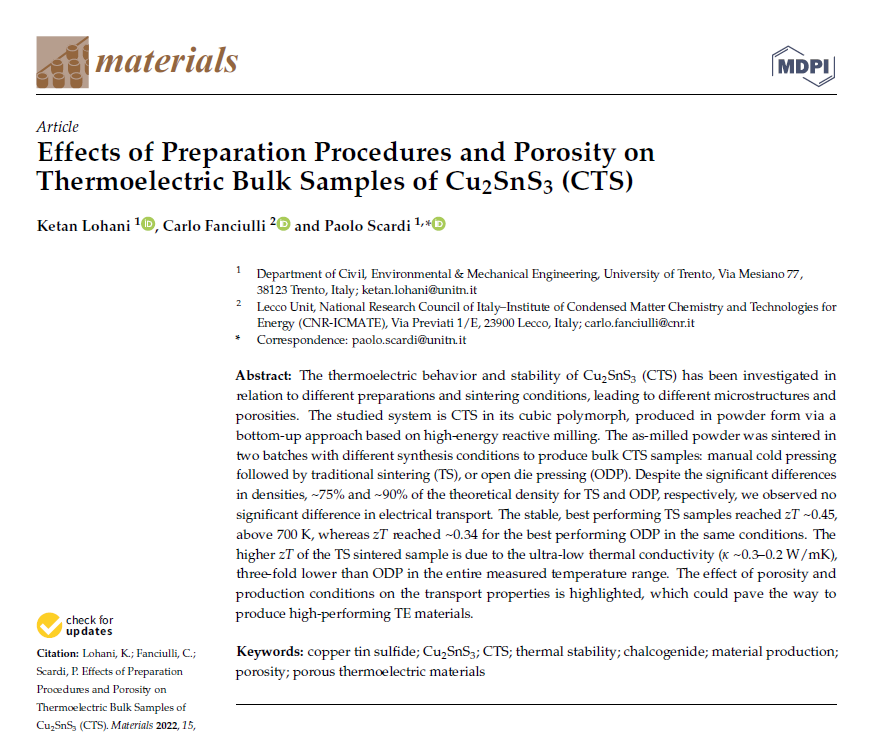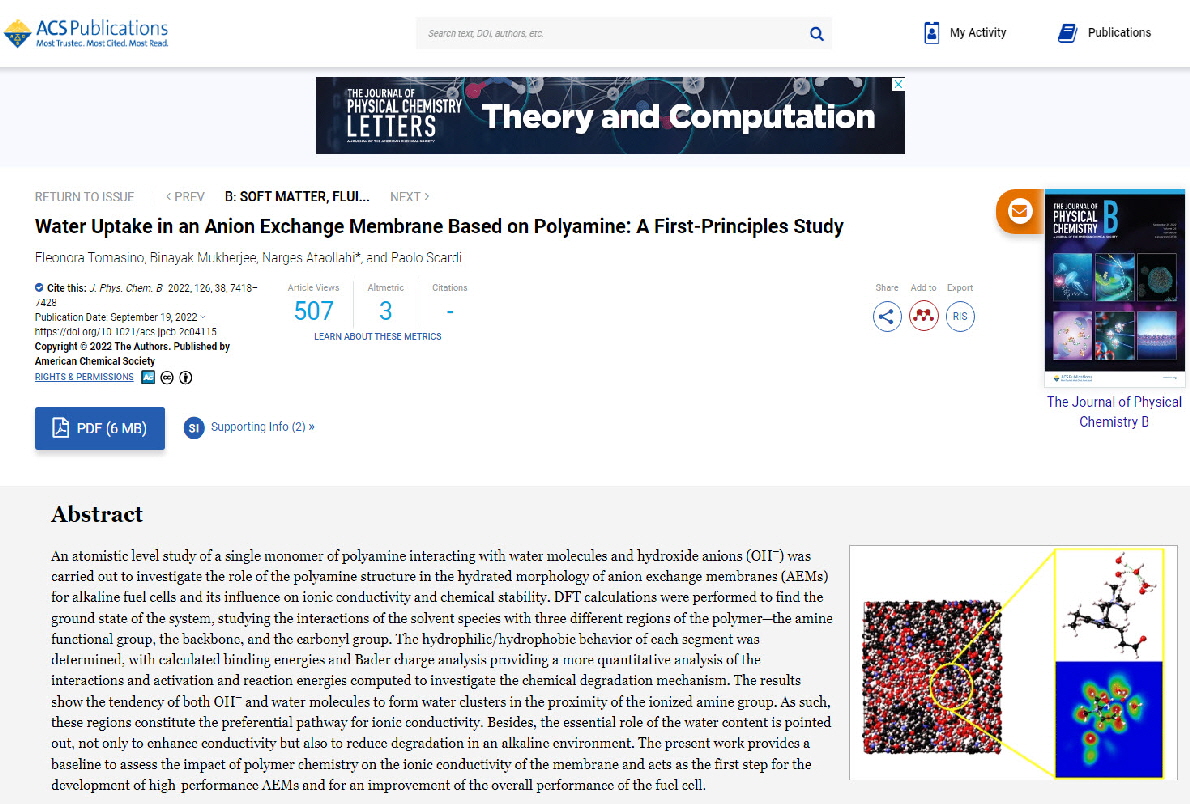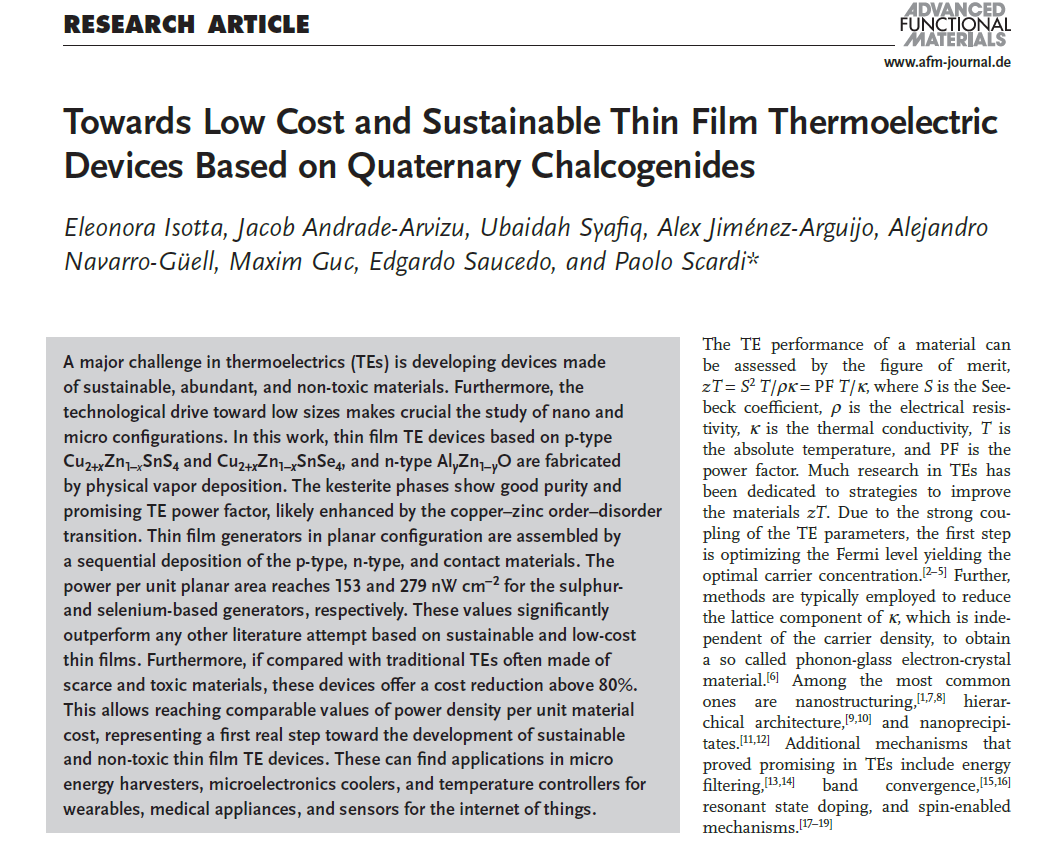September 19, 2022
Water Uptake in an Anion Exchange Membrane Based on Polyamine: A First-Principles Study
Eleonora Tomasino, Binayak Mukherjee, Narges Ataollahi*, and Paolo Scardi
J. Phys. Chem. B 2022, 126, 38, 7418–7428
https://doi.org/10.1021/acs.jpcb.2c04115
Abstract
An atomistic level study of a single monomer of polyamine interacting with water molecules and hydroxide anions (OH–) was carried out to investigate the role of the polyamine structure in the hydrated morphology of anion exchange membranes (AEMs) for alkaline fuel cells and its influence on ionic conductivity and chemical stability. DFT calculations were performed to find the ground state of the system, studying the interactions of the solvent species with three different regions of the polymer─the amine functional group, the backbone, and the carbonyl group. The hydrophilic/hydrophobic behavior of each segment was determined, with calculated binding energies and Bader charge analysis providing a more quantitative analysis of the interactions and activation and reaction energies computed to investigate the chemical degradation mechanism. The results show the tendency of both OH– and water molecules to form water clusters in the proximity of the ionized amine group. As such, these regions constitute the preferential pathway for ionic conductivity. Besides, the essential role of the water content is pointed out, not only to enhance conductivity but also to reduce degradation in an alkaline environment. The present work provides a baseline to assess the impact of polymer chemistry on the ionic conductivity of the membrane and acts as the first step for the development of high-performance AEMs and for an improvement of the overall performance of the fuel cell.

May 3, 2022
“First principles study of SnX2 (X=S, Se) and Janus SnSSe Monolayer for thermoelectric applications”,
Nanotechnology (2022). IF 3.9
doi: https://doi.org/10.1088/1361-6528/ac6c37
Himanshu Nautiyal & Paolo Scardi
Abstract
Tin-based chalcogenides are of increasing interest for thermoelectric applications owing to their low-cost, earth-abundant, and environmentally friendly nature. This is especially true for 2D materials, in which breaking of the structural symmetry plays a crucial role in tuning the electronic properties. 2D materials present a unique opportunity to manipulate the electronic and thermal properties by transforming a monolayer into a Janus monolayer. In the present work, we have investigated the thermoelectric properties of hexagonal SnS2, SnSe2 monolayer, and Janus SnSSe monolayer. Density functional theoretical (DFT) calculations points out the hexagonal Janus SnSSe monolayer as a potential high-performing thermoelectric material. Results for the Janus SnSSe monolayer show an ultra-low thermal conductivity originating from the low group velocity of the low-lying optical modes, leading to superior zT values of 0.5 and 3 at 300K and 700K for the p-type doping, respectively.
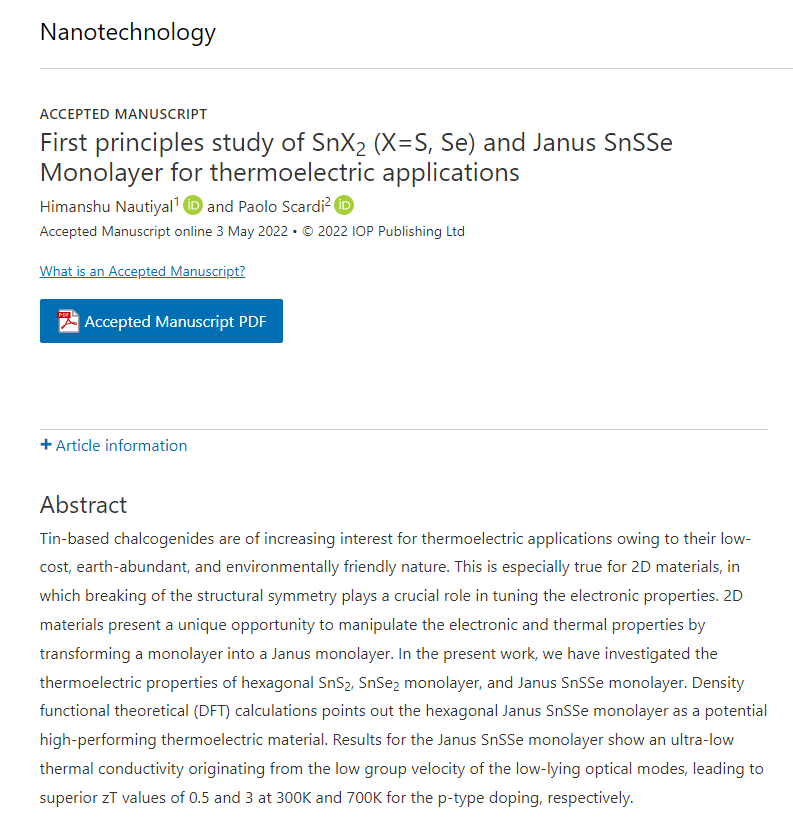

Towards low cost and sustainable thin film thermoelectric devices based on Cu-rich Cu2ZnSnS4 and Cu2ZnSnSe4
Advanced Functional Materials (2022). IF 18.8
E. Isotta, J. Andrade-Arvizu, U. Syafiq, N. Ataollahi, A. Jiménez-Arguijo, A. Navarro-Güell, M. Guc, E. Saucedo & P. Scardi,

April 19, 2022
Facile and Low-Cost Fabrication of Cu/Zn/Sn-Based Ternary and Quaternary Chalcogenides Thermoelectric Generators
Ubaidah Syafiq, Eleonora Isotta, Narges Ataollahi, Ketan Lohani, Sally Luong, Vanira Trifiletti, Oliver Fenwick, and Paolo Scardi
ACS Appl. Energy Mater. 2022
https://doi.org/10.1021/acsaem.2c00268
© 2022 The Authors. Published by American Chemical Society
In this work, Cu/Zn/Sn-based ternary and quaternary chalcogenides inks were synthesized via hot injection and/or from ball-milled powders. The synthesized inks were used to fabricate thermoelectric generators (TEGs) based on p-type chalcogenide and n-type aluminum-doped zinc oxide (AZO) thin films via spin-coating and magnetron sputtering, respectively. This work highlights the first-ever attempt in a facile and scalable method to fabricate thin-film TEGs using safe, low-cost, and abundant materials. Four different TEGs were fabricated using Cu2ZnSnS4 (CZTS), Cu2ZnSnSe4 (CZTSe), Cu2.125Zn0.875SnS3Se (CZTSSe), and Cu2SnS3 (CTS) chalcogenides. Thermoelectric transport analysis confirmed the respective p- and n-type natures of the chalcogenides and AZO, with their Seebeck coefficients compatible to be coupled in a p–n device. In addition, a full-device analysis has been carried out, and several factors affecting the performance of TEGs were investigated, including the composition, density, and presence of secondary phases in chalcogenide thin films. The maximum power per unit active planar area obtained for CZTS, CZTSe, CZTSSe, and CTS TEGs at a temperature difference (ΔT) of 160 K was ∼43, ∼188, ∼23, and ∼59 nW/cm2, respectively, making CZTSe/AZO TEG the champion device.
Keywords: thermoelectric generator (TEG) thin film Cu2ZnSn(S/Se)4 (CZTS/Se) Cu2SnS3
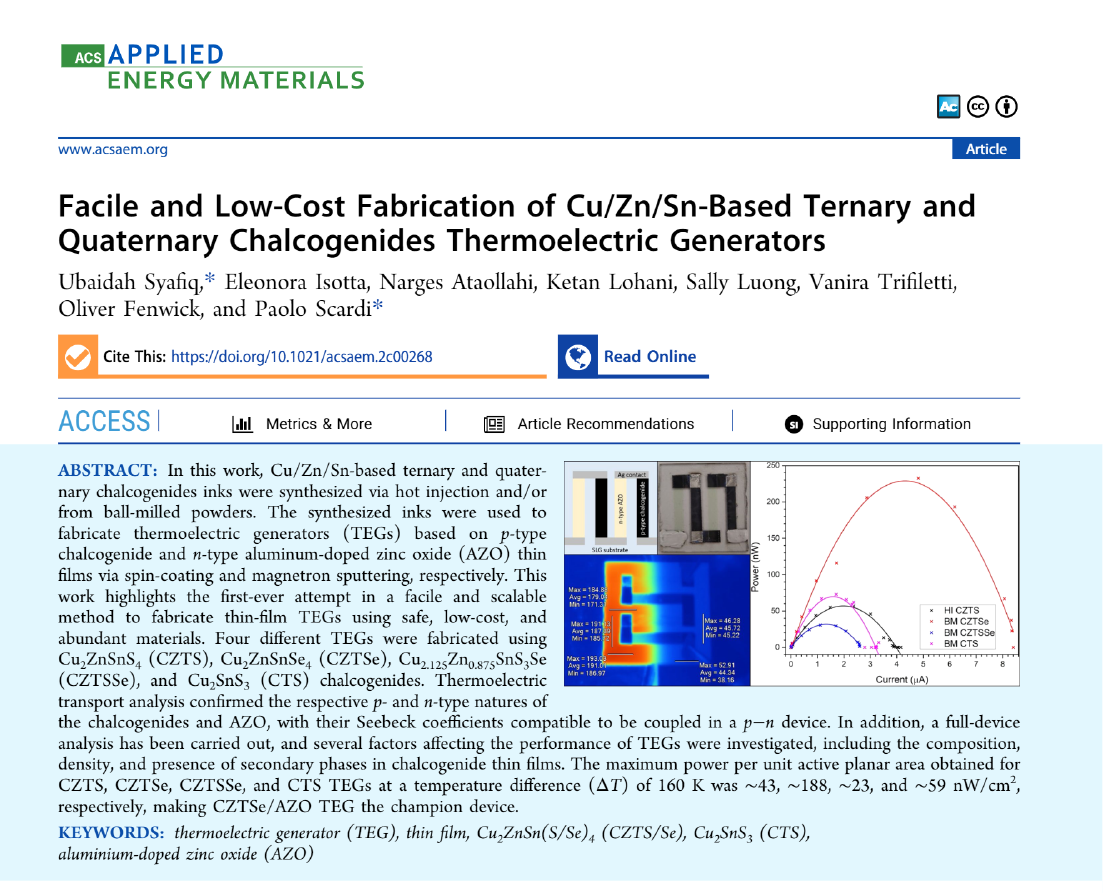
March 7, 2022
Enhanced OH− Conductivity for Fuel Cells with Anion Exchange Membranes, Based on Modified Terpolymer Polyketone and Surface Functionalized Silica
Narges Ataollahi, Eleonora Tomasino, Oscar Cotini and Rosa Di Maggio
Department of Civil, Environmental and Mechanical Engineering, University of Trento, Via Mesiano, 77, 38123 Trento, Italy
Energies 2022, 15(5), 1953; https://doi.org/10.3390/en15051953
Several modified terpolymer polyketones (MPK) with N-substituted pyrrole moieties in the main chain and quaternized amine in the side group were synthesized for use as anion exchange membranes for fuel cells. The moieties were carried by SiO2 nanoparticles through surface functionalization (Si–N), which were added to the membranes to enhance their overall properties. On increasing the amount of modified silica from 10% to 60% wt/of MPK, there was an increase in Si–N and a corresponding threefold increase in the hydroxide conductivity of the membrane. The MPK–SiN (60%) exhibited a superior ionic conductivity of 1.05 × 10−1 S.cm−1 at 120 °C, a high mechanical stability, with a tensile strength of 46 MPa at 80 °C. In strongly alkaline conditions (1 M KOH, 216 h at 80 °C), the membranes maintained about 70% of the conductivity measured in a usual environment. Fuel cell performance at 80 °C showed a peak power density of 133 mW·cm−2, indicating that using surface-functionalized SiO2 is a simple and effective way to enhance the overall performance of anion exchange membranes in fuel cell applications. View Full-Text
Keywords: polyketone; anion exchange membrane; chemical modification; functionalized silica; fuel cells; alkaline stability
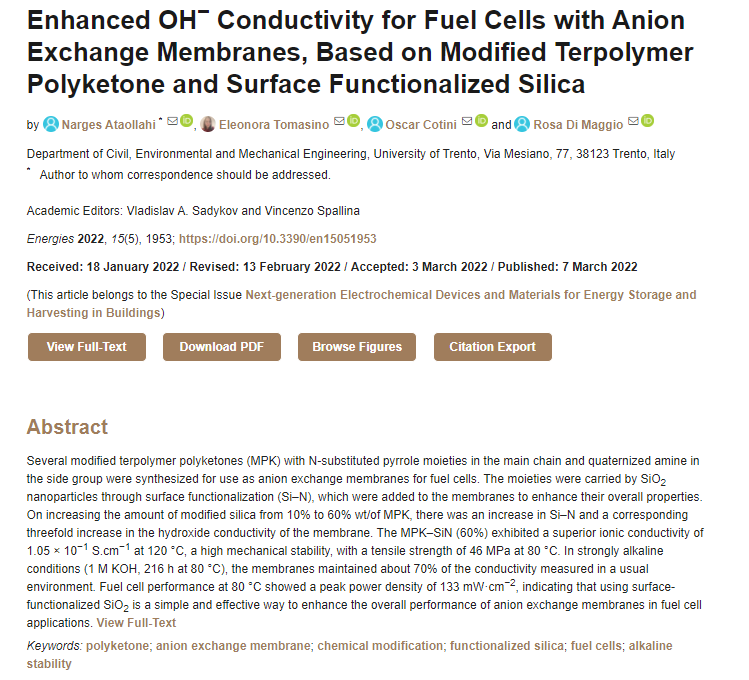
February 11, 2022
Static and dynamic components of Debye–Waller coefficients in the novel cubic polymorph of low-temperature disordered Cu2ZnSnS4
Eleonora Isotta1, Binayak Mukherjee1, Sebastian Bette2, Robert Dinnebier2 and Paolo Scardi1
(1) Department of Civil, Environmental and Mechanical Engineering, University of Trento, 77 via Mesiano, Trento 38123, Italy, and (2) Max-Planck Institute for Solid State Research, Stuttgart Germany
Correspondence e-mail: paolo.scardi@unitn.it
Cu2ZnSnS4 (CZTS) is an attractive material for sustainable photovoltaics and thermoelectrics, and several properties originate from its marked polymorphism. High-energy mechanical alloying is found to lead to a disordered phase that possesses a sphalerite-like cubic structure. This is investigated in detail with the aid of laboratory and synchrotron radiation X-ray diffraction, Raman spectroscopy, electron microscopy and ab initio molecular dynamics. The disordered cubic polymorph is preserved below 663 K. With thermal treatments above 663 K, the tetragonal kesterite phase forms, used here as a reference for structural and microstructural features. Particular attention is paid to the stacking arrangement: a significant fraction of twin faults was found in the disordered cubic samples, which then progressively annealed with domain growth and with the transition to the ordered tetragonal phase. This study also focuses on Debye–Waller coefficients, which were found to be considerably larger for the disordered cubic than the tetragonal sample. Indeed, disorder leads to an ∼1 Å2 upward shift through the temperature range 100–700 K, a feature confirmed by ab initio calculations, which points to a particularly high contribution from disordered Sn cations. This supports the general understanding that structural disorder introduces a temperature-independent static contribution to the atomic mean-square displacement. Debye–Waller coefficients are found to be a good measure of this disorder, known to have a critical effect on transport properties.

January 18, 2022
Effects of preparation Procedures and Porosity on Thermoelectric Bulk Samples of Cu2SnS3 (CTS)
Ketan Lohani1, Carlo Fanciulli2 and Paolo Scardi1
(1) Department of Civil, Environmental & Mechanical Engineering, University of Trento, Via Mesiano 77, 38123 Trento, Italy
(2) Lecco Unit, National Research Council of Italy–Institute of Condensed Matter Chemistry and Technologies for Energy (CNR-ICMATE), Via Previati 1/E, 23900 Lecco, Italy
https://doi.org/10.3390/ma15030712
